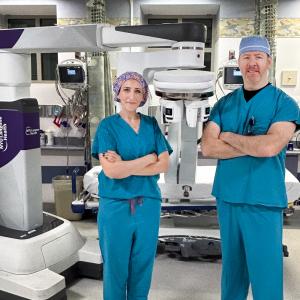Dr. Seth A. Gross Tests a Machine-Learning Program That Spots Polyps Clinicians Might Miss

Dr. Seth A. Gross says artificial intelligence could save lives by helping to spot subtle polyps during colonoscopies.
Photo: Karsten Moran
Colonoscopies prevent thousands of colorectal cancer deaths every year, but even the most skilled gastroenterologists can miss a potentially deadly polyp growing flush against the colon wall or nestled within its nooks and crannies. In fact, according to one large study published in 2017, one in eight suspicious growths are missed during the procedure. Seth A. Gross, MD, director of clinical care and quality in the Division of Gastroenterology and Hepatology at NYU Langone, believes artificial intelligence (AI) may soon deliver a powerful solution. “Some of these polyps can be very subtle in appearance,” notes Dr. Gross, associate professor of medicine. “If AI can help us with a second set of eyes when we’re looking for them, that could save lives.”
Dr. Gross has long embraced new technology in his clinical practice. He was among the first gastroenterologists in the country to use a 360-degree endoscope in clinical practice. Recognizing the vast potential of AI to improve outcomes for his patients, last year, he began using an experimental machine-learning program from a Chinese company that’s trained on thousands of colonoscopy images to distinguish between healthy and diseased colons. During a colonoscopy, the software scans the same real-time monitor image that Dr. Gross sees and draws boxes around any parts of the image it deems a potential lesion. “That focuses my attention on a specific part of the image, so I can take a closer look,” he says. He also provides feedback to help the company improve its software.
Is the system spotting polyps that Dr. Gross might not have found himself, or that a different practitioner might have missed? To answer that question, in June he will kick off the first multicenter clinical trial of the system to compare the rate at which precancerous polyps are found with and without the AI software. Anything that leads to even a small improvement in polyp detection is well worth pursuing, he notes. “When we find and remove a precancerous polyp, we’ve just interrupted one pathway to colon cancer,” Dr. Gross says.
If the system proves helpful, says Dr. Gross, it will likely be made available widely to the field in a commercial version within two years. Along the way, he adds, it will probably be extended to assist with endoscopies intended to spot precancerous tissues in the stomach and esophagus, such as those associated with Barrett’s esophagus, a condition related to reflux disease. “The software will continue to improve and get better at dealing with nuances in the appearance of lesions on different tissue surfaces,” he says. “I think we’re just seeing the tip of the iceberg in what AI systems like this can do for us in this field.”

